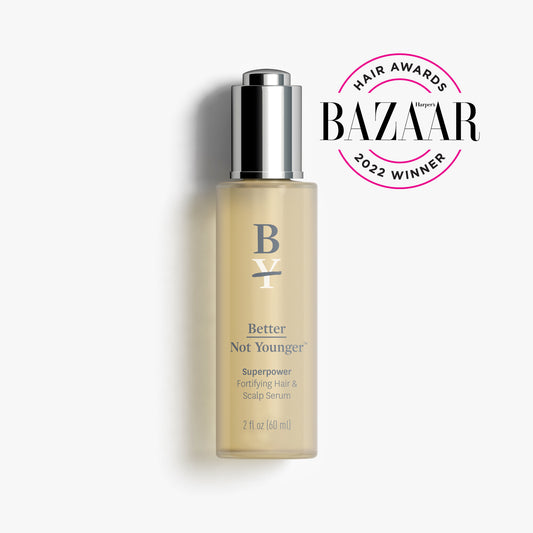How Do I Choose A Hair Serum?
As the years go by, the volume and shine associated with young-looking hair may be replaced by brittle, fine, and dull hair, generally linked to aging. This transformation results from environmental and genetic influences that affect your hair shaft and follicle cells.
Locating the best hair serum to counteract the unique hair-raising issues of aging is not a simple task. This is because not all serums are created equally — some can weigh your hair down while others leave it feeling sticky and often fail to treat the root problem.
Many brands use ingredients that may improve certain hair types and do little for others. It is crucial to find a product suited to the changing qualities of your aging hair. Choose a hair serum with powerful ingredients designed especially for you for superior results.
What Is Hair Serum?
Hair serum is a liquid hair care product used to repair and protect strands, stimulate follicles, and nourish your scalp. Some perform one of these tasks, and others effectively perform all three.
Repair and Protect Your Strands
Some hair serums are designed to repair aging or damaged hair by distributing robust ingredients to the hair shaft, nourishing tresses with folic acid, biotin, and vitamins, resulting in healthier, more elastic hair. Some serums contain silicone, keratin, antioxidants, or other ingredients to protect your hair from humidity, heat, pollution, or harmful UV rays.
Stimulate Your Follicles
Some serums like Better Not Younger's Superpower Fortifying Hair and Scalp Serum contain ingredients like:
-
Ginger and caffeine — To stimulate hair follicles by increasing blood flow.
-
Niacinamide — A water-soluble B-vitamin that helps rebuild hair keratin by supporting hair follicle function.
Nourish Your Scalp
Damaged hair often has difficulty retaining nutrients and repairing itself because your scalp loses nutrients as it ages. Serums massaged directly onto the skin at your hair's roots deliver nutrients that bolster follicle health while boosting your hair's strength.
The Anatomy of Your Hair
Your hair anatomy comprises three layers: the medulla, the cortex, and the cuticle.
-
Medulla — The medulla is the innermost layer and helps give hair its elasticity.
-
Cortex — The middle layer, called the cortex, is constructed of keratin protein bundles and makes up the bulk of your hair. Your cortex must be nutrient-rich because it gives hair structure, tensile strength, color, and texture.
-
Cuticle — The outer layer is called the cuticle. This thin and transparent layer protects inner hair structures. The cuticle should be sealed and protected from moisture and chemicals.
Aging Hair Challenges and Solutions
When most women hit their 40s, their hair revolts, causing fresh styling challenges commensurate with aging hair. This can make hair serum selection feel like a colossal undertaking, but for every problem, there is a solution:
Frizzy Hair
Hair cuticles have overlapping cell structures that resemble roof shingles when viewed under a microscope. When your hair is smooth, the shingles lie flat and can resist water; however, age-related damage can cause the cuticles to lift, allowing water molecules into the hair structure and causing frizziness.
Solution: If you have frizzy hair, choose a serum with cuticle-sealing ceramide-NG, an oil that shields and protects strands from injury. Sealing the cuticle locks in moisture prevents breakage and gives your hair a smooth, glossy look.
Dry Hair
Each of your follicles contains a sebaceous gland that releases an oil called sebum. Sebum removes dead skin cells and keeps your scalp and hair moisturized. As you age, your sebaceous glands create less and less sebum, leading to dry hair and an itchy scalp.
Solution: Since dry hair often begins on the scalp, using a serum that stimulates and moisturizes it is a good idea. Serums with niacinamide stimulate scalp circulation and decrease inflammation; both are vital for proper follicle function.
Thinning Hair
Hair loss can affect your entire body or scalp and can be caused by medical conditions, medications, heredity, and aging-related hormonal changes. An overabundance of the androgen hormone dihydrotestosterone (DHT) can incite hair loss in aging women.
Solution: Select a hair serum that supports and strengthens hair follicles for healthier, thicker-looking hair.
Fine Hair
Your hair may start out thicker depending on your genetics and ethnicity, but over time the quality of your hair can change. The strands narrow due to diminished protein in the cortex, fewer cuticle layers, and follicle shrinkage, causing fine or wispy hair.
Solution: To address fine hair, feed your head and hair with a serum containing sea kelp extract. Sea kelp contains many vitamins and minerals, including iodine, vitamins A and C, and zinc, to supplement your scalp, feed your follicles, and strengthen your hair.
Gray Hair
Your genes decide how soon you turn gray, though your hair does not actually “turn” gray. The melanocyte cells in your scalp inject pigment (melanin) into hair cells that contain keratin. As you age, melanin production is reduced, eventually causing your hair to grow gray or white.
Solution: If you decide to celebrate your grays, choose a serum to keep your hair looking bright and hydrated with nourishing vitamins and oils.
Choose a Hair Serum Packed with Nourishing Ingredients
Settling on the suitable hair serum for your evolving hair can be the difference between striking and vivid or lifeless and dull. The key to beautiful hair in your 40s, 50s, 60s, 70s, and beyond is selecting a serum packed with nourishing ingredients to stimulate your scalp, fortify your hair follicles, and promote healthier, thicker-looking hair.
Consider Better Not Younger’s Fortifying Hair & Scalp Serum, specifically designed for the unique challenges of aging hair. It absorbs with ease, is non-greasy, and is simple to apply. Visit our Better Not Younger product page to see our full line of hair care solutions.

